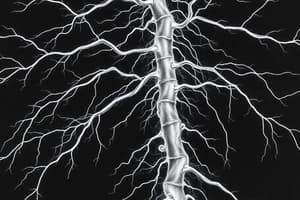Podcast
Questions and Answers
What is the primary function of motor systems?
What is the primary function of motor systems?
- Controlling sensory input
- Directing and coordinating movement (correct)
- Processing emotional responses
- Regulating internal organ functions
Which type of movement is characterized by intricate planning and execution?
Which type of movement is characterized by intricate planning and execution?
- Reflexes
- Stereotypic movements
- Self-expressive movements (correct)
- All of the above
Which of the following is an example of a stereotypic movement?
Which of the following is an example of a stereotypic movement?
- Blinking your eyes
- Typing on a keyboard
- Walking (correct)
- Reaching for a glass of water
Which of the following is NOT considered a primary component of the motor system?
Which of the following is NOT considered a primary component of the motor system?
What is the key difference between self-expressive and stereotypic movements?
What is the key difference between self-expressive and stereotypic movements?
What kind of movement relies on continuous feedback from the sensory system?
What kind of movement relies on continuous feedback from the sensory system?
Which of these brain areas is primarily responsible for planning and coordinating movement?
Which of these brain areas is primarily responsible for planning and coordinating movement?
Where do upper motor neurons originate?
Where do upper motor neurons originate?
What is the primary function of lower motor neurons?
What is the primary function of lower motor neurons?
Which of these is NOT a descending motor tract?
Which of these is NOT a descending motor tract?
What is the primary distinction between the pyramidal and extrapyramidal tracts?
What is the primary distinction between the pyramidal and extrapyramidal tracts?
Which of the following is NOT part of the basal ganglia?
Which of the following is NOT part of the basal ganglia?
What is the primary role of the basal ganglia in motor control?
What is the primary role of the basal ganglia in motor control?
Which of these pathways within the basal ganglia is associated with increased movement?
Which of these pathways within the basal ganglia is associated with increased movement?
What is the function of dopamine in the nigrostriatal pathway?
What is the function of dopamine in the nigrostriatal pathway?
Damage to which brain structure is associated with Parkinson's disease?
Damage to which brain structure is associated with Parkinson's disease?
Which of these is a characteristic of descending motor pathways?
Which of these is a characteristic of descending motor pathways?
Damage to structures within the spinal cord can affect which of the following?
Damage to structures within the spinal cord can affect which of the following?
What is the primary function of the corticobulbar tract?
What is the primary function of the corticobulbar tract?
Which of these descending motor pathways is primarily responsible for maintaining balance?
Which of these descending motor pathways is primarily responsible for maintaining balance?
Which of the following is NOT a characteristic of the extrapyramidal system?
Which of the following is NOT a characteristic of the extrapyramidal system?
Flashcards
Motor Systems
Motor Systems
Areas of the nervous system controlling movement.
Goal-directed Movement
Goal-directed Movement
Planned movements based on specific needs or situations.
Stereotypic Movements
Stereotypic Movements
Repetitive automatic movements like walking or swimming.
Reflexes
Reflexes
Signup and view all the flashcards
Planned Movements
Planned Movements
Signup and view all the flashcards
Closed-loop movement
Closed-loop movement
Signup and view all the flashcards
Open-loop movement
Open-loop movement
Signup and view all the flashcards
Premotor area
Premotor area
Signup and view all the flashcards
Supplementary motor area
Supplementary motor area
Signup and view all the flashcards
Upper motor neurons
Upper motor neurons
Signup and view all the flashcards
Lower motor neurons
Lower motor neurons
Signup and view all the flashcards
Corticobulbar tract
Corticobulbar tract
Signup and view all the flashcards
Corticospinal tract
Corticospinal tract
Signup and view all the flashcards
Extrapyramidal system
Extrapyramidal system
Signup and view all the flashcards
Basal ganglia
Basal ganglia
Signup and view all the flashcards
Direct pathway of basal ganglia
Direct pathway of basal ganglia
Signup and view all the flashcards
Indirect pathway of basal ganglia
Indirect pathway of basal ganglia
Signup and view all the flashcards
Striatonigral projection
Striatonigral projection
Signup and view all the flashcards
Descending motor pathways
Descending motor pathways
Signup and view all the flashcards
Motor dysfunctions
Motor dysfunctions
Signup and view all the flashcards
Study Notes
Motor Systems Organization
- Motor systems are areas of the nervous system responsible for controlling movement.
- Movement can be self-expressive, specific, or goal-directed, e.g., surgery, or stereotypic & repetitive, e.g., walking.
- Movements can be closed-loop (reflex-controlled) or open-loop.
- Closed-loop movements use sensory feedback for continuous adjustment.
- Open-loop movements are triggered internally and don't rely on continuous feedback.
- Movement control involves premotor and supplementary motor areas.
Premotor and Supplementary Motor Area
- The premotor area helps control core muscle movements for posture during movement.
- The supplementary motor area is hypothesized to be involved in planning and coordinating movement.
- Upper motor neurons begin their process in the premotor cortex (PMC).
Lower Motor Neuron
- Lower motor neurons are also called the second-order neuron.
- They are located in the anterior horn of the spinal cord or in brainstem nuclei.
- These neurons directly innervate muscles through their axons.
Control of Movement
- The motor system includes cortical and subcortical areas.
- Afferent inputs (feedback from sensory systems) influence motor control (closed loop).
- Sensory input includes somatosensory cortex, cerebellar afferents, and proprioception (sensing muscle position).
Efferent Outputs
- Efferent outputs include descending tracts:
- Corticobulbar tract: cortex to medulla
- Corticospinal tract: cortex to spinal cord
- Pyramidal: voluntary movement.
Studying That Suits You
Use AI to generate personalized quizzes and flashcards to suit your learning preferences.




